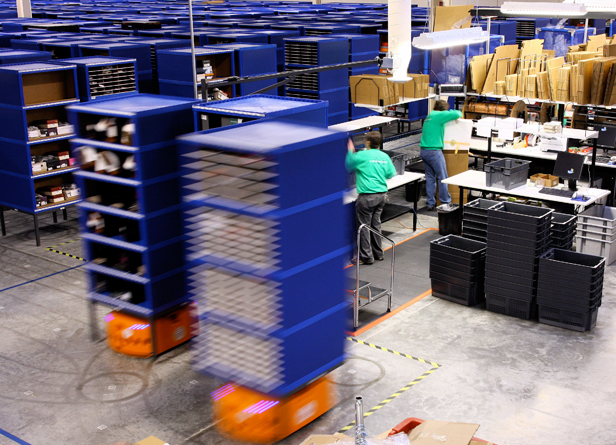Automate or Perish

In Automate This, a book due out next month, author and entrepreneur Christopher Steiner tells the story of stockbroker Thomas Peterffy, the creator of the first automated Wall Street trading system. Using a computer to execute trades, without humans entering them manually on a keyboard, was controversial in 1987—so controversial that Nasdaq pressured him to unplug from its network. Then, with a wink, Peterffy built an automated machine that could tap out the trades on a traditional keyboard—technically obeying Nasdaq rules. Peterffy made $25 million in 1987 and is now a billionaire.
Today, automated trading bots account for nearly three-quarters of U.S. equity trading by volume. Trading houses plow millions into fiber optics and microwave dishes so their algorithms can send trades a millisecond faster than the next guys’. And although the first trading robot was built 25 years ago, most of the change on Wall Street has occurred during just the last few years. When it comes to automation, we may be in the elbow of an exponential curve.
In this month’s Technology Review business report, we look at what it takes to succeed at the cutting edge of automation. Consider Amazon. The company not only automated book buying but also turned the computer systems it built to do so into a service called Amazon Web Services, making them available for anyone wanting to repeat the feat.
And now Amazon’s founder, Jeff Bezos, is placing new bets on automation. In March, Amazon paid $775 million for Kiva Systems, a company that makes robotic dollies that zip across warehouse floors carrying shelves full of goods. Kiva found it was more productive to have the humans who “pick, pack, and stow” items stay in one place and let intelligent shelves come to them. Among other reasons, Amazon said, it bought the robotics firm because the technology offered the chance to reduce labor requirements at its dozens of warehouses.
This is an example of what is going on in the economy more broadly. As the MIT economist David Autor has argued, the job market is being “hollowed out.” High-wage, high-skill employment is still being created—and so are many poorly compensated service industry jobs for food preparers, home care aides, and others. It’s the jobs in the middle that are disappearing: certain clerical, sales, and administrative jobs and some on factory floors.
Now a combination of growing computing power and advances in data crunching mean automation is primed to threaten not just tax preparers and travel agents but higher-rung jobs such as those in the medical and legal professions, where software can increasingly do things like analyze images and understand speech more accurately and in more contexts than ever before. Any work that is repetitive or fairly well structured is open to full or partial automation. Being human confers less and less of an advantage these days.
Some economists believe automation may explain why U.S. economic output has grown since 2007 while the number of jobs has fallen. That kind of dislocation is unusual. The U.S. economy has evolved from agriculture to manufacturing to service industries. Each time jobs were destroyed in one sector, they were replaced elsewhere. Data from the Bureau of Labor Statistics provide some clues to what the next economy will look like. Among the 10 fastest-growing new job categories between 2009 and 2011, seven have the word “computer” or “software” in them, according to an analysis by Matt Beane, a doctoral student at MIT’s Sloan School of Management.
Some say what’s taking shape is a more productive symbiosis between man and machine—and successful businesses will be the ones that optimize it. Rodney Brooks, founder of ReThink Robotics in Boston, believes that a new type of general-purpose robot could reinvigorate manufacturing. The machines he’s building aren’t hardwired for any one job; they’re flexible, so many types of businesses could use them for a variety of production tasks. The company’s aim is to democratize automation the way the PC did for computing, spurring similar efficiency gains.
There’s definitely good news here: more people than ever have access to affordable, powerful tools that can help them and their businesses become more productive. Take Todd Ruback, a privacy lawyer in Warren, New Jersey, who handles legal paperwork for companies that have lost sensitive data like credit card numbers. The job involves filing forms and notifying consumers in dozens of states, each with slightly different laws and deadlines. He’s been field-testing software made by a company called Co3 Systems that automates much of the process. It walks attorneys through what they need to do and prints out the right form letters for each state.
Ruback estimates that the software cuts the time it takes him to handle a case by 10 to 20 percent. But don’t lawyers bill by the hour? Why would Ruback want something that makes it all go faster? It’s pretty simple, he says. The software makes him more efficient. And if he doesn’t automate, the other guy will.
Keep Reading
Most Popular
Large language models can do jaw-dropping things. But nobody knows exactly why.
And that's a problem. Figuring it out is one of the biggest scientific puzzles of our time and a crucial step towards controlling more powerful future models.
The problem with plug-in hybrids? Their drivers.
Plug-in hybrids are often sold as a transition to EVs, but new data from Europe shows we’re still underestimating the emissions they produce.
Google DeepMind’s new generative model makes Super Mario–like games from scratch
Genie learns how to control games by watching hours and hours of video. It could help train next-gen robots too.
How scientists traced a mysterious covid case back to six toilets
When wastewater surveillance turns into a hunt for a single infected individual, the ethics get tricky.
Stay connected
Get the latest updates from
MIT Technology Review
Discover special offers, top stories, upcoming events, and more.